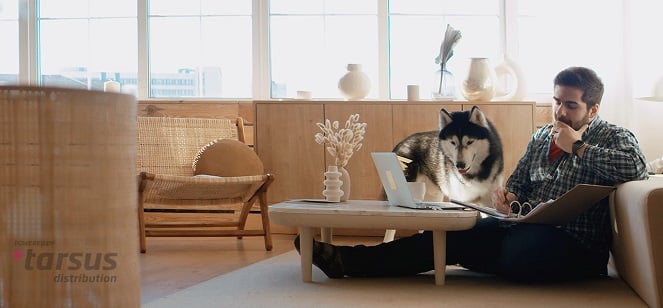
A hybrid model provides your business with the structure and sociability of an office environment, as well as the flexibility and independence of remote working.

In the midst of a Microsoft Teams world, a global pandemic and an economic downturn, how do we keep inspired, focused and connected to others? How do we fight off the feelings of physical and mental exhaustion, isolation and burn-out?
Collaboration is the watchword, but is it working? And if so, for how much longer can organisations and teams continue to work in this way?
Helene Liebenberg, chief operations officer at Tarsus Distribution has had a different experience from many of her colleagues. “Because of my role, I am at the office almost every day, as is my team. But many other divisions in the organisation are not, and that’s where a certain sense of isolation comes in, and support for mental wellbeing becomes necessary.”
Another issue is that the novelty of working from home has simply worn off for some people. They have become lonely, bored with their surroundings, and tired of interacting only with family members. “I am seeing more people making the effort to come to the office for a day every now and again just so that they can catch up with colleagues in real life rather than on screen,” she adds.
As we move closer to the end of the pandemic and companies are focusing on future work arrangements for their employees, Liebenberg believes we will see a hybrid model emerging that combines working from the office and working from home.
“This hybrid model is necessary because certain people need interaction with others to maintain a sense of wellbeing and connectedness,” she says.
Gary Pickford, chief commercial officer at Tarsus Distribution, has had a different experience. With his many direct reports and disparate teams located all around the country, the move to the digital world has worked in his favour.
“It has given us the ability to accelerate communication like never before; my teams and I are fitting more meetings into our daily schedules, employee engagement has been phenomenal, and productivity is at an all-time high.”
Pickford believes that until the vaccine rollout percentage has improved considerably it is too soon for business leaders to declare that it’s time to return to the office exclusively
“The only people who fear having their employees work from home are those who don't run their lives digitally. Compared to the physical world, the digital world is 100% faster. In my experience, people respond to emails, messages, and other forms of communication almost instantaneously. The idea that you need to watch people working for them to be productive is a complete fallacy and archaic.”
That said, in other areas of the business, such as operations and other more internally focused roles, people are beginning to feel lost and are longing for the comfort of other faces.
Liebenberg and Pickford agree that moving toward a hybrid model of work is the only sustainable solution. What that will look like, however, is a work in progress. But their aim is to find an equitable solution that offers employees the opportunity to work from anywhere they’d like, whether that’s at home, in a coffee shop or at the office.
It’s an approach that takes people’s family lives and home environment into consideration. Pickford says that Tarsus Distribution’s approach has already seen employees turn down job offers from other companies because they do not offer the same level of flexibility and empathy that the employees have come to appreciate.
This flexibility is not perfect, however, and there are some serious issues to contend with. With loadshedding here to stay, connectivity is a major challenge. Not everybody has the resources to find alternate backup solutions for when the power goes down.
This also affects different roles, differently. A receptionist who cannot work because of load shedding in the middle of the day cannot make up for lost time after hours because the phones must be answered between 08:00 and 17:00.
“Every one of our managers has had their eyes opened to the different circumstances our employees find themselves in, especially those with more limited economical means,” Pickford says. “Aside from access to fibre, for example, in the first few days of lockdown, as we moved our people home with their technology, we became very aware of the risks they were taking by travelling on a bus or in a taxi with a laptop in their bag.”
Liebenberg agrees. “The challenge for organisations is that you have to run a business in such a way that you meet the needs of the average employee. The pandemic has provided much insight for every organisation into the battles that different employees face. We cannot help everyone all the time, but we can certainly try harder to understand the challenges they face.”
“As we move closer to the end of the pandemic and companies are focusing on future work arrangements for their employees, I believe we will see a hybrid model emerging that combines working from work and working from home.” Helene Liebenberg, chief operations officer, Tarsus Distribution
Want to know more? Click here to read a great article we found on the mixture of home and office working.

© Copyright 2024 Tarsus Distribution